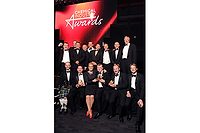Global Titanium Dioxide Industry in Recovery
The $12 billion global titanium dioxide pigment industry improved profitability in 2010 compared to 2009, as rebounding demand led to fixed cost dilution and real price recovery from mid-year. TZ Minerals International Pty Ltd. has announced that, according to its annual independent in-depth analysis of the global TiO2 sector, the weighted average manufacturing cash cost increased by 2% in 2010, while sector revenues simultaneously increased by 28% on a U.S. dollar basis. The net result was further improvement in the industry revenue to cash cost (R/C) ratio to 1.29, taking the sector back to profitability levels last seen in 2006.
In 2008, the global TiO2 sector was financially at rock-bottom. Short-term cost spikes in energy and sulfur had significantly inflated the cost base; at the same time, real pricing was declining. Cost relief led to improved profitability in 2009, at a time when pricing and volume was under pressure. In 2010, pricing was leading the rebound in profitability; however, cost inflation is expected in the next two to three years, particularly as titanium feedstock producers insist on high prices to fund necessary resource replenishment.
In 2010, chloride plants regained control, accounting for six of the 10 lowest cost plants in the world. According to TZMI’s independent analysis, E. I. du Pont de Nemours and Co. (DuPont) held the lowest cost position with its 340,000 tpa plant in DeLisle, MS. Plants operated by all five of the major global producers (DuPont, Cristal Global, Huntsman Corp., Kronos Worldwide and Tronox Inc.) were in among the 20 lowest cost facilities. Half of the 20 lowest cost plants were located in China.
However, operating with a low manufacturing cash cost platform was not the only precursor to profitability: product quality and price were key factors requisite for producers to return acceptable margins. DuPont’s DeLisle plant was again the most profitable facility in this year’s study, with the company’s other four chloride facilities ranking among the world’s top 10 most profitable for 2010. Huntsman’s 60,000 tpa Malaysian operation was the most profitable sulfate plant, coming ninth in the global rankings. The most profitable Chinese sulfate pigment plant came in at 16 out of 57 plants analyzed in 2010.
On average, industry profitability expanded by more than $140 per ton in 2010, compared to 2009. The cost gap between chloride and sulfate technology expanded 13% in 2009, primarily as a result of higher energy prices and two high-cost chloride plants eliminated from the 2010 analysis due to closure in 2009: Cristal’s Baltimore and Tronox’s Savannah, GA, facilities. DuPont remains the industry leader with the highest profitability rating, when all five plants in its portfolio are consolidated. According to TZMI, DuPont’s weighted average revenue-to-cash cost ratio was 1.54, approximately 19% higher than the industry-wide average for 2010.
North American plants were the most profitable in 2010 (R/C of 1.46), followed by those in Asia-Pacific (R/C of 1.22) and Europe (R/C of 1.17). All regions had plants at both ends of the industry-wide profitability curve; however, North American plants dominated the most profitable end of the spectrum.
The combined weighted average revenue-to-cash cost ratio increased 6% for the five global producers in 2010, accounting for 65% of the production covered in the study. The R/C ratio for the regional producers increased by 4% in 2010, and this collective of companies accounted for 29 plants, of which 87% was sulfate-route production.
“Manufacturing cost is expected to increase by around 30% over 2010 levels by 2015,” said David McCoy, senior partner. “Although rising costs are substantial, it is likely that margins will expand further in the coming years as a result of a global TiO2 pigment supply shortage, as already witnessed with sharp price increases in the first quarters of 2011.”
McCoy also cautioned that “expectations the market will increase capacity to meet the rising demand are limited by the ability to source titanium feedstock, which is also forecast in deficit.”
For more information, visit www.tzmi.com.
In 2008, the global TiO2 sector was financially at rock-bottom. Short-term cost spikes in energy and sulfur had significantly inflated the cost base; at the same time, real pricing was declining. Cost relief led to improved profitability in 2009, at a time when pricing and volume was under pressure. In 2010, pricing was leading the rebound in profitability; however, cost inflation is expected in the next two to three years, particularly as titanium feedstock producers insist on high prices to fund necessary resource replenishment.
In 2010, chloride plants regained control, accounting for six of the 10 lowest cost plants in the world. According to TZMI’s independent analysis, E. I. du Pont de Nemours and Co. (DuPont) held the lowest cost position with its 340,000 tpa plant in DeLisle, MS. Plants operated by all five of the major global producers (DuPont, Cristal Global, Huntsman Corp., Kronos Worldwide and Tronox Inc.) were in among the 20 lowest cost facilities. Half of the 20 lowest cost plants were located in China.
However, operating with a low manufacturing cash cost platform was not the only precursor to profitability: product quality and price were key factors requisite for producers to return acceptable margins. DuPont’s DeLisle plant was again the most profitable facility in this year’s study, with the company’s other four chloride facilities ranking among the world’s top 10 most profitable for 2010. Huntsman’s 60,000 tpa Malaysian operation was the most profitable sulfate plant, coming ninth in the global rankings. The most profitable Chinese sulfate pigment plant came in at 16 out of 57 plants analyzed in 2010.
On average, industry profitability expanded by more than $140 per ton in 2010, compared to 2009. The cost gap between chloride and sulfate technology expanded 13% in 2009, primarily as a result of higher energy prices and two high-cost chloride plants eliminated from the 2010 analysis due to closure in 2009: Cristal’s Baltimore and Tronox’s Savannah, GA, facilities. DuPont remains the industry leader with the highest profitability rating, when all five plants in its portfolio are consolidated. According to TZMI, DuPont’s weighted average revenue-to-cash cost ratio was 1.54, approximately 19% higher than the industry-wide average for 2010.
North American plants were the most profitable in 2010 (R/C of 1.46), followed by those in Asia-Pacific (R/C of 1.22) and Europe (R/C of 1.17). All regions had plants at both ends of the industry-wide profitability curve; however, North American plants dominated the most profitable end of the spectrum.
The combined weighted average revenue-to-cash cost ratio increased 6% for the five global producers in 2010, accounting for 65% of the production covered in the study. The R/C ratio for the regional producers increased by 4% in 2010, and this collective of companies accounted for 29 plants, of which 87% was sulfate-route production.
“Manufacturing cost is expected to increase by around 30% over 2010 levels by 2015,” said David McCoy, senior partner. “Although rising costs are substantial, it is likely that margins will expand further in the coming years as a result of a global TiO2 pigment supply shortage, as already witnessed with sharp price increases in the first quarters of 2011.”
McCoy also cautioned that “expectations the market will increase capacity to meet the rising demand are limited by the ability to source titanium feedstock, which is also forecast in deficit.”
For more information, visit www.tzmi.com.
Looking for a reprint of this article?
From high-res PDFs to custom plaques, order your copy today!





